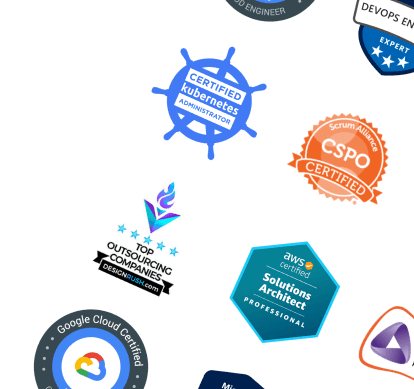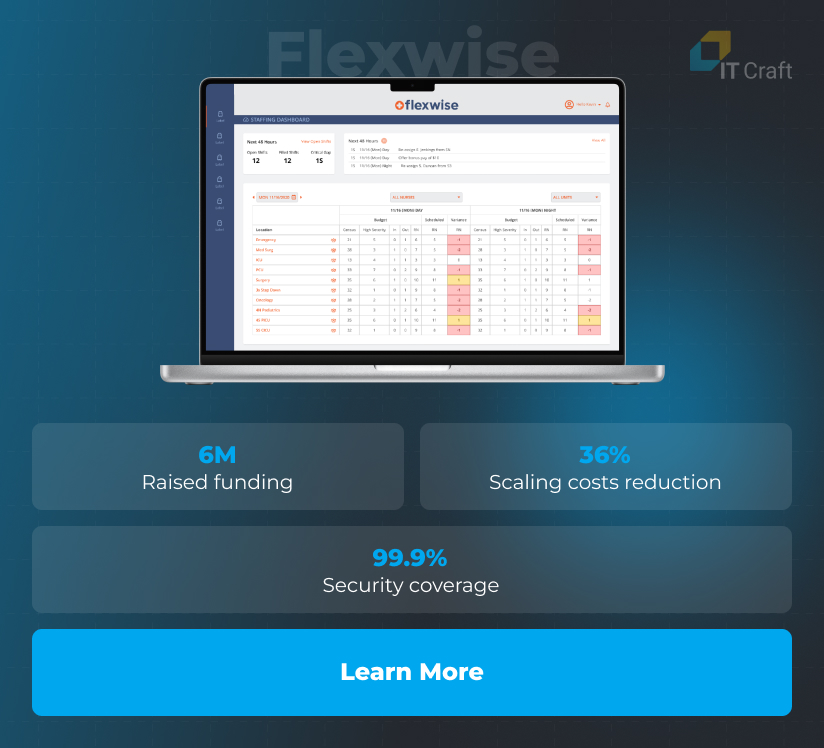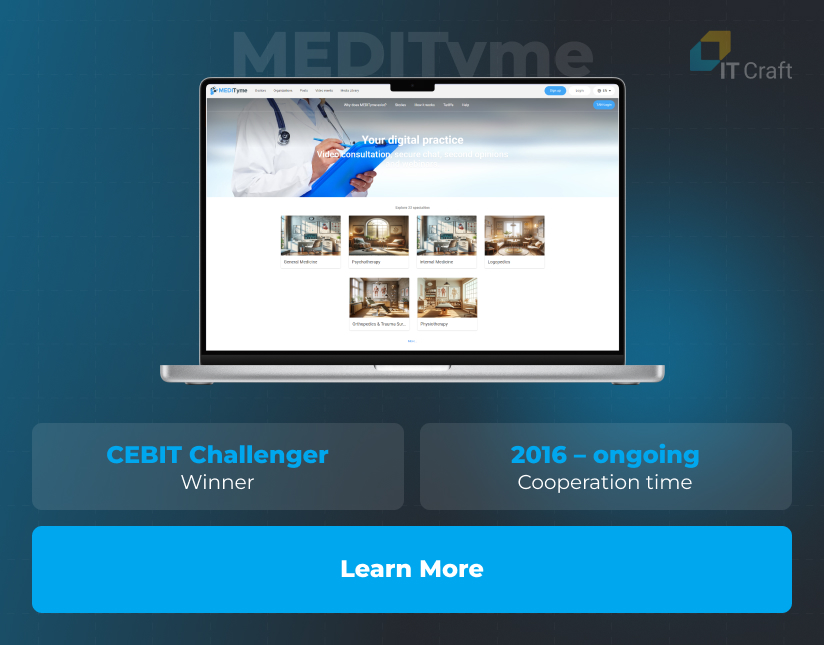The importance of expert-level healthcare software development services continues to increase while healthcare providers face unprecedented transformational challenges.

Adapting to changes can be difficult as they superimpose technological considerations and concerns, such as upholding regulations, maintaining a high level of security, dealing with legacy source code, and more.
Let’s discuss the top technology challenges in healthcare from a software development provider’s point of view below and analyze the key points to consider when investing in health tech.
1 Top Ten IT Challenges in Healthcare
Healthcare is a highly integrated industry that affects many stakeholders, depends on complex processes, and operates valuable data. This determines many healthcare industry challenges.
Healthcare organizations must weigh every decision carefully, ensuring it meets a specific challenge but does not make it prone to others at the same time, e.g., implementing AI in healthcare to improve diagnostics in a regulatory-compliant way that won’t lead to hefty fines due to misuse of sensitive patient data.
Note down the following top technology challenges in healthcare:

Cyber Threats
The healthcare industry is a top target for cybercriminals who scan for weaknesses and can attack any organization, regardless of size.
According to the statistics on healthcare data breaches collected by HIPAA Journal, the number of data breaches and affected patient records is trending upward.
Six of the top ten largest data breaches recorded by HIPAA Journal took place in 2023 and 2024, in addition to the many others out of the top ten that happened during these two years. The number of compromised health records is unprecedentedly high:

Source: HIPAA Journal
The reasons for the growing interest are the high value of medical records on the dark market and the immense costs of a successful breach. For instance, the total cost of responding to a ransomware attack on the Change Health system is between $2.3B and $2.45B.
To cope with constant cybersecurity challenges in healthcare, maintainers, and owners of healthcare digital systems must keep a special focus on:
- introducing enhanced security measures and strict access policies,
- identifying and removing vulnerabilities, and
- proactively monitoring emerging attack patterns and threats
Regulations Compliance
Particular standards for collecting, storing, processing, and disclosing sensitive patient information vary in different states and countries; they can become an entry barrier for new healthcare solutions and a growing challenge for existing ones.
Non-compliance or regulation violations can result in substantial fines and penalties, which is why companies may postpone entering a new market or slow down feature deliveries while the development team must work on meeting compliance requirements.
Still, a proactive approach to regulations can turn this challenge in healthcare technology into an opportunity. The organization can increase trust among users and partners in its digital system by meeting security standards.
The project team must conduct regular (every 3 – 6 months) audits to ensure it complies with regulations.
Also, the team should design and maintain flexible software architecture as part of the proactive approach to IT problems in healthcare. Flexibility lets the team adapt to emerging regulations within provided deadlines.
Complex Processes
Software developers working on an IT issue in healthcare must be careful because they deal with numerous interconnected processes that can unexpectedly affect related systems.
An outage caused by an unsuccessful update can not only halt internal operations within a single organization but also disrupt its partners, suppliers, or multiple patients.
For instance, the misconfigured Crowdstrike update negatively affected care delivery at hospitals and medical practices in the USA, Great Britain, Germany, and Israel by making EHR systems and other mission-critical software unavailable.
A new system, a major update, or software optimization must start with a Discovery Phase or a risk management plan. The team identifies risks and designs a mitigation plan to ensure that they can quickly regain control in an unfavorable situation.
Also, the development team should slowly deliver updates to the production environment, making them available to a limited user group and proceeding with a full-scale update only if all runs smoothly.
Talent Shortage
While reliance on digital technologies increases during healthcare digital transformation, talent shortage becomes an acute problem for many service providers.
A study by GlobalData noted that 43% of respondents reported the lack of digital skills by employees as their biggest obstacle, while the demand for tech-savvy specialists is increasing quickly.
Organizations can address the shortage with internal upskill/reskill programs. However, they should factor in that employees may consider the tech skills program a low priority, being focused on direct responsibilities, and additional incentives could be required.
The situation is similar with engineering talents. There is a low supply of many tech roles, including healthcare software developers, DevOps engineers, cybersecurity experts, etc.
Outsourcing software development, integrations, and maintenance to a reliable healthcare development vendor could be an answer to the short—and long-term shortage of tech talent.
It can also allow healthcare organizations to benefit from cutting-edge technologies and approaches, such as cloud services, security consulting, DevSecOps, value-based Agile development, and more.
Legacy Source Code
73% of healthcare organizations use legacy systems, which presents a threefold challenge: risks, costs, and hassles.
Too often, legacy software lacks vendor support and does not receive the newest security patches, making old software vulnerable to simple hacking techniques.
Replacing a legacy system can be expensive, requiring a significant budget increase for new hardware/cloud time, licensing, data migration, custom software development, and more.
There are further problems. Integrations can be difficult or unavailable. Scalability is limited because cloud migration is not possible, and maintenance is cumbersome. Also, talent shortage can be even more acute for legacy solutions as experienced programmers retire and young specialists are not interested in learning old tech.
Healthcare organizations could concentrate on gradually replacing legacy systems, prioritizing features that bring immediate business value or present the biggest risks, and skipping less important ones.
User Experiences
Usability is a major concern when it comes to upgrades or replacements. It requires a careful study of how to adapt the solution to be implemented into the organization’s processes because it is crucial to design an intuitive system that takes minimal to no learning time.
A challenge here is studying and improving existing experiences. For instance, employees can optimize time expenditures by:
- using hotkeys
- performing actions in a certain sequence
- being accustomed to specific arrangements of screen elements
They may turn to silent resistance or clashes if they cannot complete tasks in the usual way or easily find things in anticipated places. Or, they may implement shortcuts that could compromise software security.
The project team needs to interview stakeholders and learn how they use software to identify required improvements. Several iterations of user feedback can be necessary to create an optimal experience.
Also, it is crucial to add features that users have wanted for a long time but never received and design them in a way that streamlines workflow and encourages users to use best security practices intuitively.
Growing Patient Expectations
Growing patient expectations are a significant driver for digital transformation, which healthcare providers should prioritize in their strategies.
Patients demand efficiency and convenience similar to retail or digital banking when interacting with a healthcare service provider, e.g.:
- reschedule an appointment on the go from a smartphone
- fill in a digital intake form in minutes using prompts
- access test results and prescriptions from a self-service portal
- appoint return visits as a teleconsultation
and more.
Healthcare providers need stand-alone, separate patient software for cybersecurity and user experience reasons.
First, digital solutions for patients become an additional entry point for cybercriminals, and the development team must carefully isolate them from the rest of the system to prevent a disruptive attack.
Second, healthcare providers’ solutions mostly reflect their internal processes and can be impractical for patients, offering features and workflows the latter do not understand. Learning from the best practices of consumer apps and adapting those experiences in health tech is beneficial.
IoMT (Internet-of-Medical -Things)
The global market of IoT healthcare devices is estimated to increase from $127.7B in 2023 to $289.2B in 2028 at a 17.8% CAGR, as these devices help optimize treatment costs and increase the quality of provided services.
Connected healthcare devices allow healthcare providers to improve the monitoring of chronic patients, personalize care, and increase safety by detecting an emergency state early.
At the same time, organizations face a range of IoT challenges in healthcare, including:
- increase in cyber attack surface
- difficulties of integrating medical IoT devices for a seamless data exchange as devices from different manufacturers can use incompatible data formats and communication protocols
- problems with continuous storing and handling large volumes of patient data
- interruptions with real-time data transmission in locations with weak internet coverage
- high upfront costs of medical IoT healthcare devices
It is crucial to start with a pilot project for a limited user group to identify risks and opportunities of IoT implementation in healthcare, prioritizing patients who need remote monitoring the most.
AI Implementation
There is a growing interest in gen AI among healthcare organizations: 85% of industry leaders either plan an investment or are already working on implementation. However, 67% point out that employees feel skeptical about using AI.
On the one hand, AI can help:
- gain insights based on available patient data,
- improve the accuracy of diagnosing cancer or other emerging serious diseases,
- reduce wait time,
- recognize concerning messages from patient communication,
- automate drafting documentation,
- decrease the amount of administrative work,
and more.
Conversely, AI in healthcare challenges, such as lack of transparency and potential bias, can lead to losses rather than wins. When doctors do not understand how an AI model makes predictions, they will not trust it. More importantly, they cannot use it to justify medical decisions.
Medical professionals should be actively included in AI implementation to be able to explain and interpret the received results, avoiding situations when they must deal with a black box.
Also, employees are concerned that AI will disrupt their roles, potentially leading to implementation resistance. This is why administrators need to evaluate negative outcomes alongside positive ones and prepare a mitigation plan.
Enhance your digital capabilities with AI
Let’s discuss your business goals and analyze how AI technologies could help you meet them.
Contact Us
Sustainability
Healthcare plays a vital role in increasing decarbonization efforts and building sustainable operations. According to Deloitte’s 2024 Global Health Care Sector Outlook, healthcare contributes nearly 5% of global greenhouse gas emissions.
Sustainability initiatives address multiple aspects, such as reducing emissions across supply chains, improving energy efficiency, transitioning to zero-emission vehicles, switching to green energy sources, and more.
Digital technologies become part of a sustainability strategy. With their help, organizations can:
- replace paper documentation with digital processes where possible,
- introduce CI/CD and DevOps practices to optimize software infrastructure and eliminate waste of digital resources,
- switch to cloud providers using renewable energy,
- use smart devices to optimize and automatically manage electricity and heating inside a facility, adjusting them to the time of the day and workload
Also, collected and stored data enables organizations to measure impact and identify further improvement areas.
2 How Can HealthTech Improve Healthcare?
Let’s discuss strategic goals your organization should reach when implementing cutting-edge technologies and undergoing digital transformation.
HealthTech should help you:

Enhance Diagnostics
Combining an Electronic Health Records (HER) solution and AI diagnostics software decreases the probability of medical error because doctors have access to a patient’s history of diagnoses and treatment and a support tool that can immediately recognize specific patterns of serious diseases.
Improve Interoperability
Challenges of interoperability in healthcare can slow down management processes. You need to ensure automated data updates and exchanges between different systems that employees, patients, and partners use for tests, treatment, and activities management.
Also, integrate electronic prescriptions to decrease the chances of unauthorized access to regulated medications.
Expand Care Offerings
Telemedicine app development and IoMT enable you to expand healthcare offerings, including teleconsultations and in-home treatment, ensuring patients can easily contact their doctor. Self-service portals increase patient trust and satisfaction by increasing treatment transparency and engaging patients.
Optimize Costs
Doctors and administrators efficiently use time and resources, thanks to innovative software (automation solutions, HER, predictive analytics, facility management, etc.), which lets organizations address issues such as the quality and affordability of healthcare services.
Does your organization pay only for the resources it uses?
Schedule a consultation with our DevOps experts. Let’s analyze your consumption and eliminate server resource waste.
Contact Us
Improve Staff Retention
Innovative solutions enable you to reduce workload, prevent burnout, and retain skilled talents looking for a dynamic workplace. You can better adapt to talent scarcity by encouraging employees to stick to their roles and providing regular workflow enhancements based on their pain points.
Comply with Government Initiatives and Regulations
Software updates can help you meet existing and emerging regulations, which can address such sensitive aspects of patient treatment as protection of user data, tracking of prescription drugs, or fair use of AI technologies.
3 IT Craft’s Expertise in Solving Healthcare Technology Challenges
Has your organization faced a shortage of available tech talent, decreased project delivery pace, or emerging software updates and scalability issues?
IT Craft can help.
Our engineering team will apply acquired competencies and decade-long expertise to take care of your healthcare development project’s tech side:
- complete a discovery stage to identify tech risks and healthcare IT challenges, and then determine an optimized implementation path
- quickly develop an MVP solution for an emerging market
- get a derailed healthcare project back on track
- update and expand an existing system
- monitor infrastructure security 24/7/365 and optimize the consumption of computational resources
You benefit from flexible cooperation terms; you can:
- hire a team led by a dedicated project manager
- assign one or several developers who become an external part of your in-house team and report to you directly
- select managed services for constant software monitoring and supervision
Flexwise
Flexwise started as an on-demand platform for hiring nursing professionals and morphed into a full-fledged staff administration system.
The client needed
The client had a partially completed system that could quickly allow clinic administrators to hire vetted professionals. The IT Craft team’s task was to improve, finalize, and help with maintenance.
How we helped
IT Craft developers reworked available monolithic source code into microservices to ensure flexibility and scalability and delivered the required MPV functionality within the promised timeline.
Later, the team focused on feature deliveries and software maintenance, keeping the client’s system fast, secure, and responsive.

MEDITyme (part of XPERTyme)
A part of the XPERTyme platform, MEDITyme is a HIPPA-/GDPR-compliant solution for video calls between doctors and patients. It can be used upon registration or as a white-label solution under an organization’s brand.
The client needed
The client needed to launch an MVP of the video conferencing platform within a tight deadline to present it at major tech events.
How we helped
The team met the client’s timeline needs, ensuring the system was ready for the presentation, which let the client win users. The IT Craft team focused on platform improvement and feature expansion, launching an enhanced solution for the healthcare industry.

! Final Thoughts
Multiple challenges in the healthcare industry will persist in the future, requiring healthcare organizations to become increasingly technology-aware.
Technical expertise becomes a valuable asset for healthcare organizations as it lets them adapt to ongoing and emerging healthcare technology issues that can disrupt operations and lead to colossal losses when left unattended.
Moreover, healthcare organizations face growing expectations from authorities, employees, and patients regarding the digital experiences they provide, and meeting these expectations requires technical expertise.
Still, expectations are an opportunity that enables you to take a different market position. Therefore, if you are thinking of enhancing your digital system, the best time to act is now.
FAQs
In our opinion, the biggest technological challenge healthcare faces today is cybersecurity because of the high value of patient data, the growing costs of an attack, and the devastating consequences far beyond a single organization.
The key technologies impacting healthcare include:
- EHR
- gen AI
- IoMT
- telemedicine
- patient-centered software
Here are some essential steps that can help overcome the challenges of technology in healthcare:
- regularly audit the software system
- apply zero-trust policy
- conduct pen testing
- update and upgrade technology
- install security patches
- comply with industry regulations
- audit and improve user experiences
- enhance system interoperability and secure data exchange


